Abstract
A radiometric method to determine the MIC of ansamycin (LM427) for Mycobacterium avium complex clinical isolates has been developed. It is based on a comparison of the conventional growth curve determination and the radiometric detection of growth (growth index) in the same liquid medium (7H12 broth). This new method requires less time and labor than does a conventional determination of MIC in liquid medium (CFU). Other advantages of this method include relatively short periods of exposure of the drug to 37 degrees C and the composition of 7H12 broth, which has practically no substrates which could absorb or bind the drug. Thus, a more accurate estimation of the MIC in this medium can be expected than by the conventional agar dilution (proportion) method. The MICs of ansamycin appeared to be higher in agar plates than in 7H12 broth. More than 70% of the isolates had a broth-determined MIC one to three times lower than the average peak concentration of ansamycin achieved in sera of patients. The wide range of MICs suggests the importance of testing susceptibility in broth with many concentrations in addition to, or rather than in, agar plates with concentrations of 2.0 or 1.0 micrograms/ml only. Taking into account relatively low levels of ansamycin in sera of patients, it would be appropriate to compare the MICs with the levels in serum to make the outcome of chemotherapy more predictable.
Full text
PDF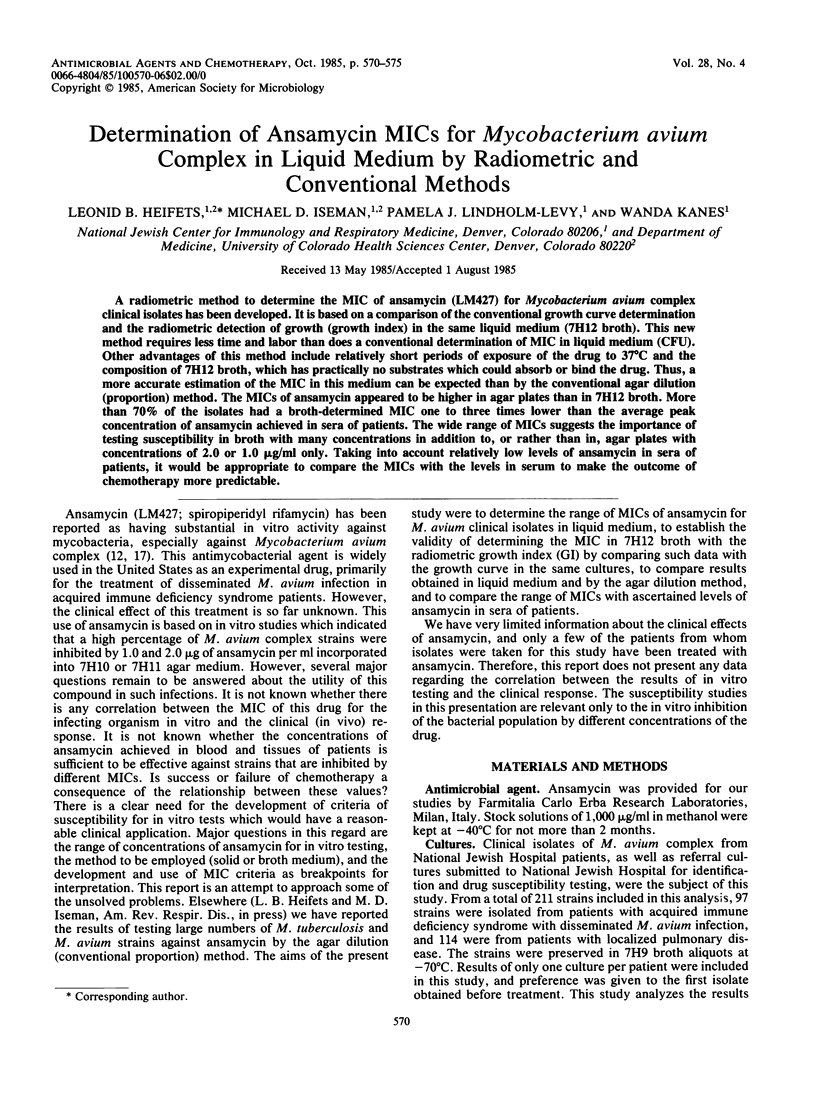
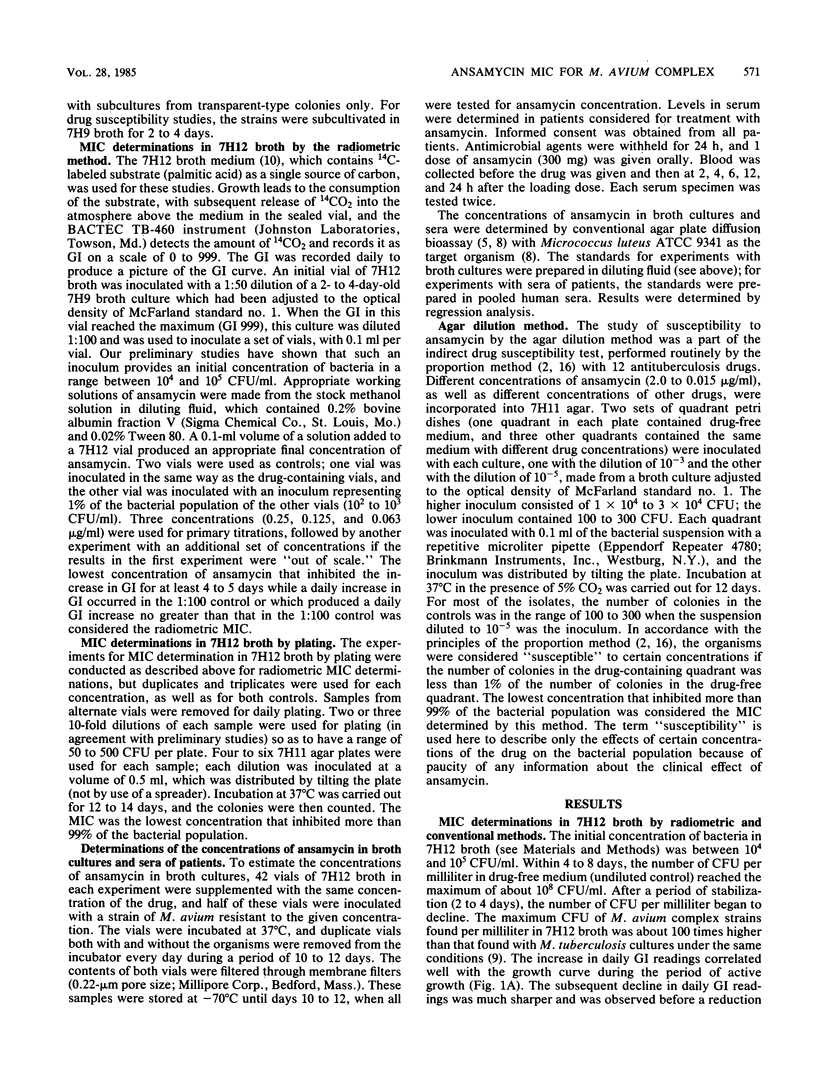
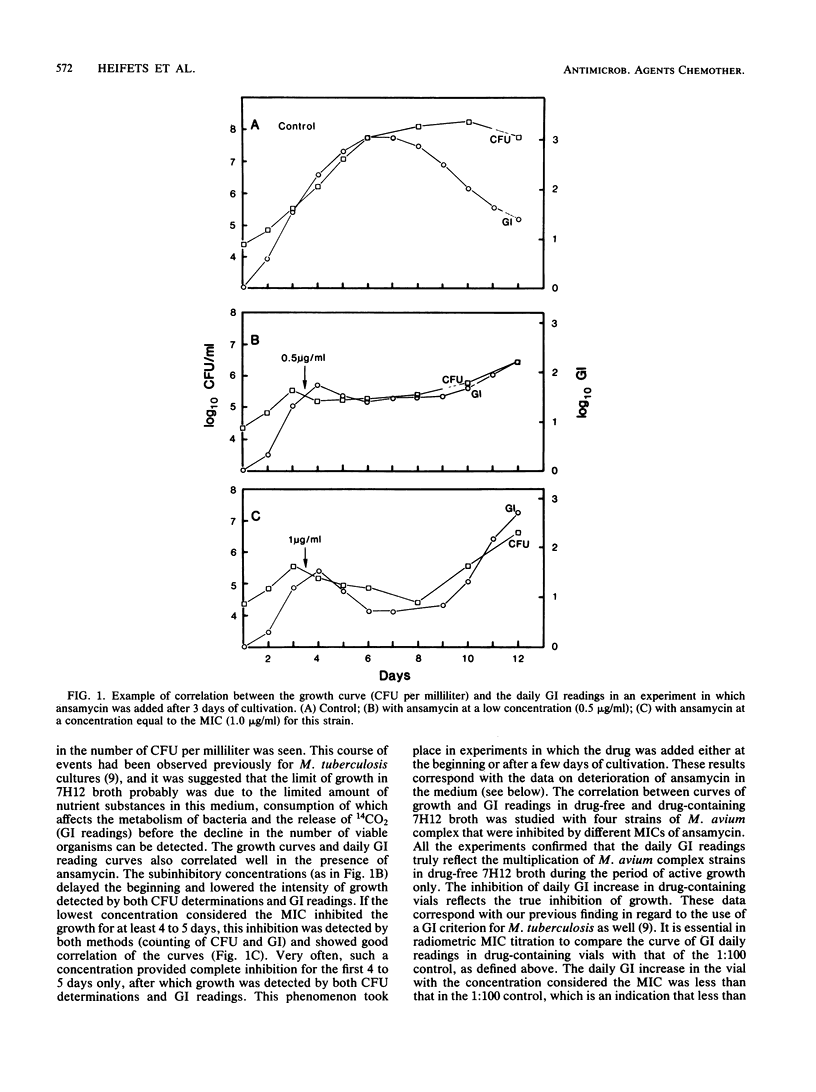
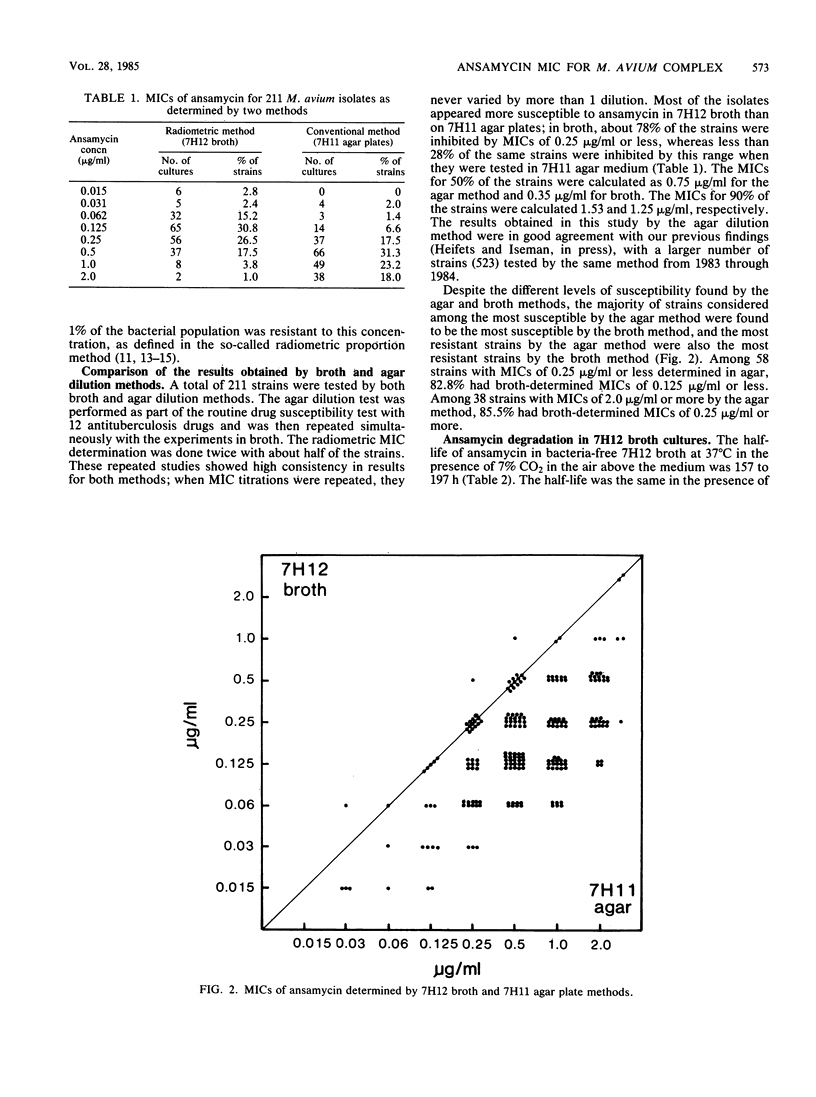
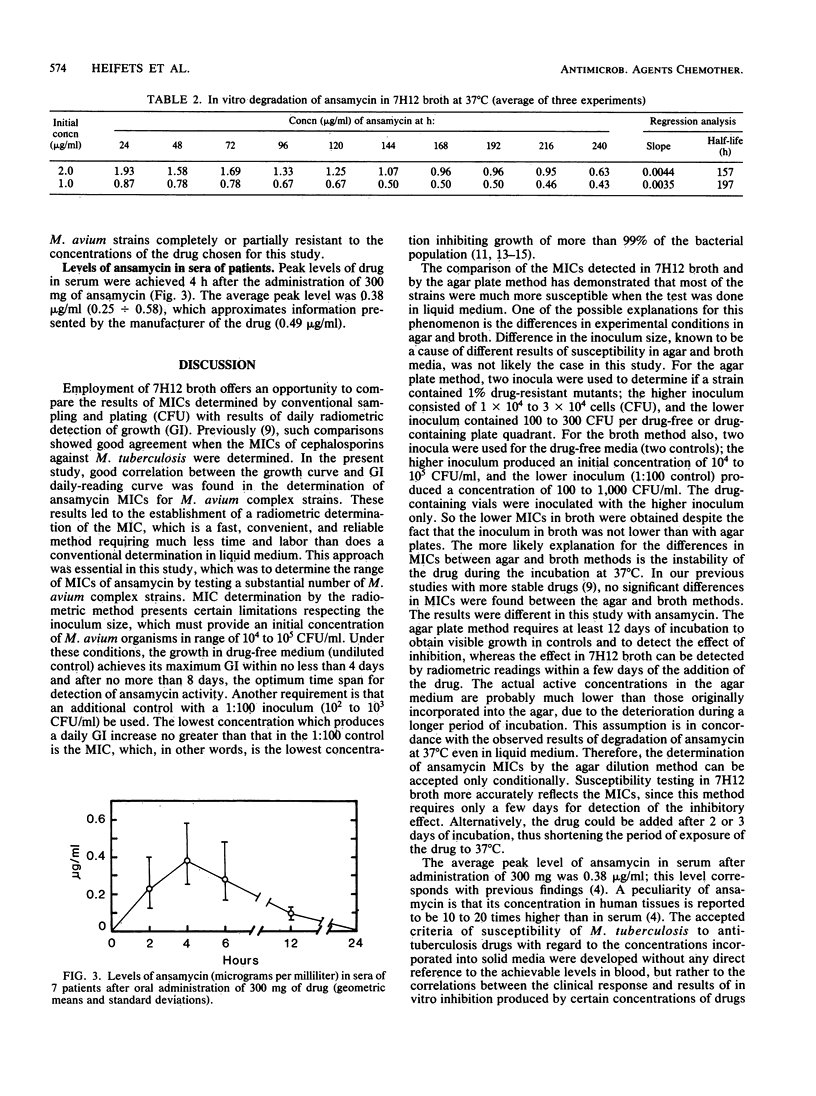
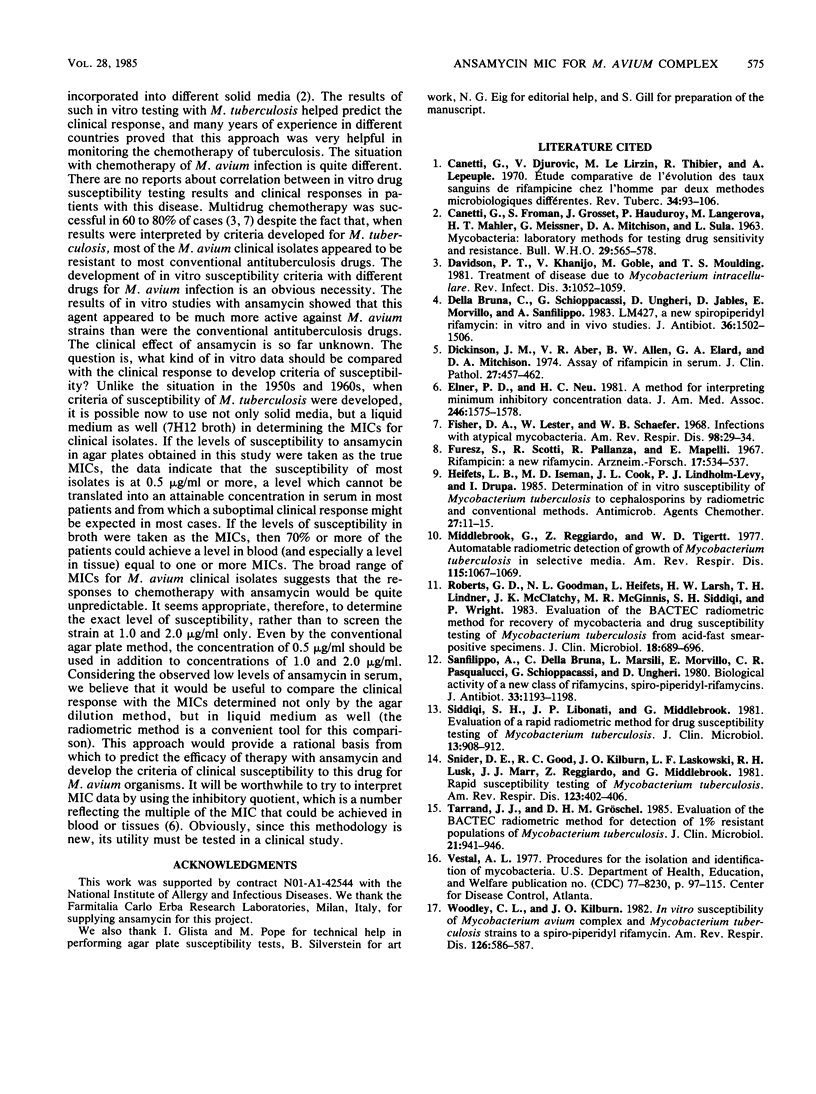
Selected References
These references are in PubMed. This may not be the complete list of references from this article.
- CANETTI G., FROMAN S., GROSSET J., HAUDUROY P., LANGEROVA M., MAHLER H. T., MEISSNER G., MITCHISON D. A., SULA L. MYCOBACTERIA: LABORATORY METHODS FOR TESTING DRUG SENSITIVITY AND RESISTANCE. Bull World Health Organ. 1963;29:565–578. [PMC free article] [PubMed] [Google Scholar]
- Canetti G., Djurovic V., Le Lirzin M., Thibier R., Lepeuple A. Etude comparative de l'évolution des taux sanguins de rifampicine chez l'homme par deux méthodes microbiologiques différentes. Rev Tuberc Pneumol (Paris) 1970;34(1):93–106. [PubMed] [Google Scholar]
- Davidson P. T., Khanijo V., Goble M., Moulding T. S. Treatment of disease due to Mycobacterium intracellulare. Rev Infect Dis. 1981 Sep-Oct;3(5):1052–1059. doi: 10.1093/clinids/3.5.1052. [DOI] [PubMed] [Google Scholar]
- Della Bruna C., Schioppacassi G., Ungheri D., Jabès D., Morvillo E., Sanfilippo A. LM 427, a new spiropiperidylrifamycin: in vitro and in vivo studies. J Antibiot (Tokyo) 1983 Nov;36(11):1502–1506. doi: 10.7164/antibiotics.36.1502. [DOI] [PubMed] [Google Scholar]
- Dickinson J. M., Aber V. R., Allen B. W., Ellard G. A., Mitchison D. A. Assay of rifampicin in serum. J Clin Pathol. 1974 Jun;27(6):457–462. doi: 10.1136/jcp.27.6.457. [DOI] [PMC free article] [PubMed] [Google Scholar]
- Ellner P. D., Neu H. C. The inhibitory quotient. A method for interpreting minimum inhibitory concentration data. JAMA. 1981 Oct 2;246(14):1575–1578. doi: 10.1001/jama.246.14.1575. [DOI] [PubMed] [Google Scholar]
- Fischer D. A., Lester W., Schaefer W. B. Infections with atypical mycobacteria. Five years' experience at the National Jewish Hospital. Am Rev Respir Dis. 1968 Jul;98(1):29–34. doi: 10.1164/arrd.1968.98.1.29. [DOI] [PubMed] [Google Scholar]
- Furesz S., Scotti R., Pallanza R., Mapelli E. Rifampicin: a new rifamycin. 3. Absorption, distribution, and elimination in man. Arzneimittelforschung. 1967 May;17(5):534–537. [PubMed] [Google Scholar]
- Heifets L. B., Iseman M. D., Cook J. L., Lindholm-Levy P. J., Drupa I. Determination of in vitro susceptibility of Mycobacterium tuberculosis to cephalosporins by radiometric and conventional methods. Antimicrob Agents Chemother. 1985 Jan;27(1):11–15. doi: 10.1128/aac.27.1.11. [DOI] [PMC free article] [PubMed] [Google Scholar]
- Middlebrook G., Reggiardo Z., Tigertt W. D. Automatable radiometric detection of growth of Mycobacterium tuberculosis in selective media. Am Rev Respir Dis. 1977 Jun;115(6):1066–1069. doi: 10.1164/arrd.1977.115.6.1066. [DOI] [PubMed] [Google Scholar]
- Roberts G. D., Goodman N. L., Heifets L., Larsh H. W., Lindner T. H., McClatchy J. K., McGinnis M. R., Siddiqi S. H., Wright P. Evaluation of the BACTEC radiometric method for recovery of mycobacteria and drug susceptibility testing of Mycobacterium tuberculosis from acid-fast smear-positive specimens. J Clin Microbiol. 1983 Sep;18(3):689–696. doi: 10.1128/jcm.18.3.689-696.1983. [DOI] [PMC free article] [PubMed] [Google Scholar]
- Sanfilippo A., Della Bruna C., Marsili L., Morvillo E., Pasqualucci C. R., Schioppacassi G., Ungheri D. Biological activity of a new class of rifamycins. Spiro-piperidyl-rifamycins. J Antibiot (Tokyo) 1980 Oct;33(10):1193–1198. doi: 10.7164/antibiotics.33.1193. [DOI] [PubMed] [Google Scholar]
- Siddiqi S. H., Libonati J. P., Middlebrook G. Evaluation of rapid radiometric method for drug susceptibility testing of Mycobacterium tuberculosis. J Clin Microbiol. 1981 May;13(5):908–912. doi: 10.1128/jcm.13.5.908-912.1981. [DOI] [PMC free article] [PubMed] [Google Scholar]
- Snider D. E., Jr, Good R. C., Kilburn J. O., Laskowski L. F., Jr, Lusk R. H., Marr J. J., Reggiardo Z., Middlebrook G. Rapid drug-susceptibility testing of Mycobacterium tuberculosis. Am Rev Respir Dis. 1981 Apr;123(4 Pt 1):402–406. doi: 10.1164/arrd.1981.123.4.402. [DOI] [PubMed] [Google Scholar]
- Tarrand J. J., Gröschel D. H. Evaluation of the BACTEC radiometric method for detection of 1% resistant populations of Mycobacterium tuberculosis. J Clin Microbiol. 1985 Jun;21(6):941–946. doi: 10.1128/jcm.21.6.941-946.1985. [DOI] [PMC free article] [PubMed] [Google Scholar]
- Woodley C. L., Kilburn J. O. In vitro susceptibility of Mycobacterium avium complex and Mycobacterium tuberculosis strains to a spiro-piperidyl rifamycin. Am Rev Respir Dis. 1982 Sep;126(3):586–587. doi: 10.1164/arrd.1982.126.3.586. [DOI] [PubMed] [Google Scholar]


